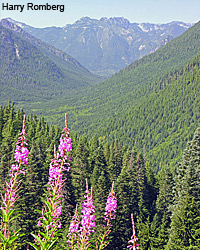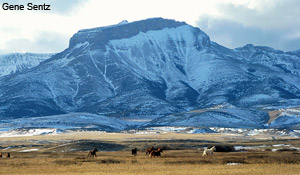Wilderness Action Heats Up
Washington really started heating up in July, as the capital city set a heat record and Congress warmed to public lands legislation, taking the first steps toward final passage on a number of bills.
In the House, Representative Peter DeFazio (D-OR) was selected to replace former representative and recently elected Senator Ed Markey (D-MA) as ranking member of the House Committee on Natural Resources. Rep. DeFazio brings 26 years of experience on the committee to the top Democratic post and has long worked to protect the Northwest's remaining ancient forests. His accomplishments include the Omnibus Oregon Wild and Scenic Rivers Act, which designated segments of 40 rivers and is (according to Pacific Rivers Council) the largest piece of river protection legislation ever enacted, and the more recently passed legislation designating the Copper Salmon Wilderness. Additionally, Mr. DeFazio is the House champion of both the Devil's Staircase Wilderness Act (S. 352 / H.R. 2491) and the Rogue Wilderness Expansion Act (H.R. 2488) that now stand before the committee. Pew looks forward to working with Rep. DeFazio to achieve significant public lands protections in the future.
On July 23, the House Subcommittee on Public Lands and Environmental Regulation heard a number of important conservation bills, including five that contain protections for public lands:
 The Sleeping Bear Dunes National Lakeshore Conservation and Recreation Act (H.R. 163), introduced by Representative Dan Benishek (R-MI), would designate more than 32,500 acres of wilderness on two islands and the popular mainland shore of Lake Michigan.
The Sleeping Bear Dunes National Lakeshore Conservation and Recreation Act (H.R. 163), introduced by Representative Dan Benishek (R-MI), would designate more than 32,500 acres of wilderness on two islands and the popular mainland shore of Lake Michigan.- Representative Mike Michaud's (D-ME) Maine Coastal Island Wilderness Act (H.R. 1808) would designate 13 islands, totaling 3,125 acres, within the Cross Island and the Petit Manan national wildlife refuges as wilderness, protecting pristine habitat for migratory seabirds and waterfowl and elevating the profile of the area to boost tourism for the area's economy.
- Representative Dave Reichert's (R-WA) Alpine Lakes Wilderness Additions and Pratt and Middle Fork Snoqualmie Rivers Protection Act (H.R. 361) expands the existing 394,000-acre Alpine Lakes Wilderness by 22,100 acres and designates parts of the Middle Fork Snoqualmie and Pratt Rivers as wild and scenic rivers. The areas that would be protected by this bill lie in the Pratt River Valley and the Middle and South Fork Snoqualmie River Valleys, an area that includes glacier-cut, U-shaped valleys, snowcapped peaks, old-growth forests, whitewater rivers, and strong native trout runs.
- The Berryessa Snow Mountain National Conservation Area Act (H.R. 1025), introduced by Representative Mike Thompson (D-CA), will protect approximately 350,000 acres (including blue oak woodlands near Putah Creek and the subalpine habitat of the Snow Mountain Wilderness) as a national conservation area.
- Representative Mark Amodei's (R-NV) Pine Forest Range Recreation Enhancement Act (H.R. 433) would create a 26,000-acre wilderness in an area of northwestern Nevada that is prime habitat for mule deer, sage grouse, and mountain lions.
Additionally, the House of Representatives passed the California Coastal National Monument Expansion Act (H.R. 1411) on July 22. The measure, introduced by Representative Jared Huffman (D-CA), would add 1,255 acres of public lands in the Point Arena-Stornetta area to the California Coastal National Monument. The wetland area is home to the Point Arena mountain beaver.
 On the other side of the Capitol, the U.S. Senate was acting on wilderness bills. On July 2, Nevada Senators Harry Reid (D) and Dean Heller (R) introduced the Douglas County Conservation Act, which would establish a 12,000-acre Burbank Canyons Wilderness Area, while providing Douglas County with greater flood control and infrastructure management options. Tennessee Senators Lamar Alexander (R) and Bob Corker (R) reintroduced the Tennessee Wilderness Act (S. 1294), which would expand five wilderness areas in the Cherokee National Forest and establishing an Upper Bald River Wilderness Area. All told, the bill would protect 20,000 acres of habitat for brook trout, black bear, bobcat and whitetailed deer. The protected areas would also include portions of the popular Appalachian Trail and Benton MacKaye Trail.
On the other side of the Capitol, the U.S. Senate was acting on wilderness bills. On July 2, Nevada Senators Harry Reid (D) and Dean Heller (R) introduced the Douglas County Conservation Act, which would establish a 12,000-acre Burbank Canyons Wilderness Area, while providing Douglas County with greater flood control and infrastructure management options. Tennessee Senators Lamar Alexander (R) and Bob Corker (R) reintroduced the Tennessee Wilderness Act (S. 1294), which would expand five wilderness areas in the Cherokee National Forest and establishing an Upper Bald River Wilderness Area. All told, the bill would protect 20,000 acres of habitat for brook trout, black bear, bobcat and whitetailed deer. The protected areas would also include portions of the popular Appalachian Trail and Benton MacKaye Trail.
On July 30, the Subcommittee on Public Lands, Forests, and Mining held a hearing on a package of bills that includes two Montana bills on which Pew has been working:
- The Forest Jobs and Recreation Act (S.37), introduced by Senator Jon Tester (D-MT), would protect nearly 700,000 acres of wilderness across the Beaverhead-Deerlodge, Lolo, and Kootenai national forests, including the East and West Pioneers, the Sapphires, Lost Cabin, and Lima Peaks, and additions to the Lee Metcalf, Anaconda-Pintler, and North Fork Blackfoot Monture Creek wilderness areas. The bill would also improve forest health and fish and wildlife habitat, as well as protect the lands for hunting, fishing, hiking, and horseback riding. Along with wilderness protection, the measure would designate areas for backcountry recreation and areas for forest stewardship.
- The Rocky Mountain Front Heritage Act (S. 364), introduced by Senators Max Baucus (D-MT) and Tester, would add 50,500 acres to the Bob Marshall Wilderness and 16,700 acres to the Scapegoat Wilderness. The legislation would also designate 208,000 acres as conservation management areas and prioritizes noxious-weed eradication and prevention on the protected lands. In August, Congress takes a break from the blistering weather in Washington and recesses for the month. We hope Americans will use the many public forums and town meetings hosted by lawmakers to express their support for public lands protection.






